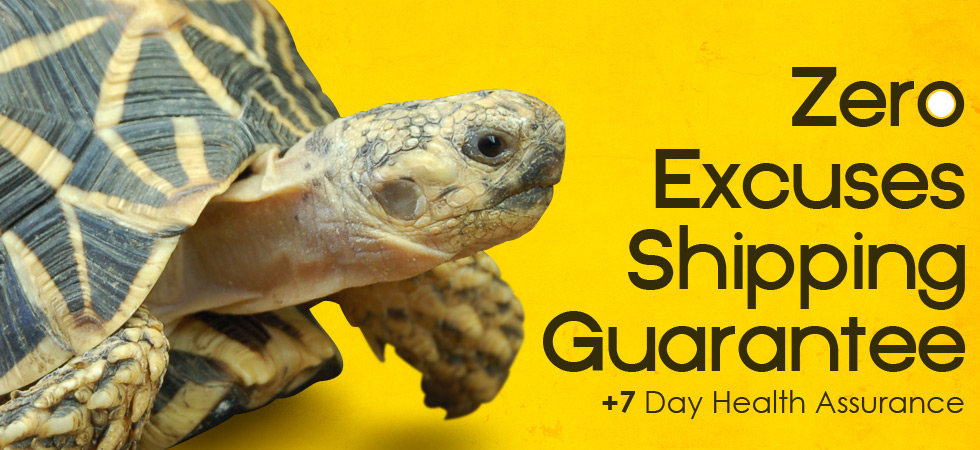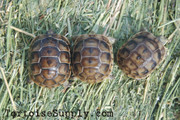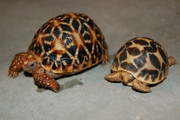Categories
- Tortoises For Sale
- Choose Your Exact Tortoise
- Lower Cost Tortoises For Sale
- Baby Tortoises For Sale (All Species)
- Pet Tortoises For Sale - 4" Size or Larger
- Cherryhead Tortoises For Sale
- Egyptian Tortoises For Sale
- Greek Tortoises For Sale
- Hermanns Tortoises For Sale
- Leopard Tortoises For Sale
- Marginated Tortoises For Sale
- Pancake Tortoises For Sale
- Radiated Tortoises For Sale
- Redfoot Tortoises For Sale
- Russian Tortoises For Sale
- Star Tortoises For Sale
- Sulcata Tortoises For Sale
- Wholesale Tortoises
- Food Items
- Lighting
- Substrates
- Tortoise Kits & Cages
- Heat Mats & Heat Sources
- Cage Furniture & Bowls
- Supplements & Vitamins
- Seed Mixes
- Medical & Tools
- Books and Literature
- Waterland Tubs
- Toys & Gifts
- Shirts & Shipping Add-Ons
- Other Products
We are often asked the differences between two species, or which species would "work best" for different people, so we wanted to throw together a simplified guide in a single page that will give a brief description of many of the common species to help streamline the selection process. To keep it simple, we are not covering care again in the article below. There is much more detailed information on each species in their respective pages (where they are sold from), as well as care guides under the Articles tab at the top. These are the quick answers we give people that call and ask about a certain species.
Sulcata tortoise
Sulcatas are a large species of tortoise that do best in warm, Southern climates. They are non hibernators that will need to be heated in the winters, or brought indoors which can be a large task for places with limited spaces or long/cold winters. They seem to handle humidity well as adults, despite being a (naturally) arid/desert climate species. They are not picky eaters, but should not have fruit (grass and veggies only). Eventually as adults, they would need to be set up in a very solid enclosure that can take their abuse (they will push hard against anything they have access to). Fragile landscaping will be destroyed in no time (think trees for shade, and grass to munch on). We love these friendly, happy tortoises, but we warn people about their eventual size constantly, and a potential buyer needs to know what they are getting themselves in to when acquiring one. They lay large clutches of eggs; generally 20 to 30 eggs at a time, so their ease of reproduction keeps the price of babies low.

Russian tortoise
These small, feisty tortoises are well known and kept by many people. They handle heat and cold very well, but prefer lower humidity areas as adults (desert type species). They will hibernate if left outside in colder climates, and can handle body temps down to just about freezing (when buried in the ground). Depending on their arrangement outside and where they are buried, they could survive outside temps probably down into the teens. I know of some that are kept outside in Salt Lake City, Utah all year. Considered less attractive or 'bland' by some people, their active personalities make up for it, and they are always happy to see you. For us, they are comparatively slow breeders, and their higher baby price reflects that.
Redfoot tortoise / Cherryhead redfoot
Redfoots are a medium sized tortoise best meant for humid climates. Florida, Louisiana, Texas, and Washington state (and similar other states) are perfect for them. They don't handle cold winters well, but they are okay with cool temps in the fall and spring, just would need to be heated during the coldest months of the year. They love rain in warm weather. For us in the desert, they can do well with shade cloth overhead and plenty of water around, but I think our heat and dryness slows down their fertility. They are adapted to eat fruit in their wild habitats, so they can handle that, and will even eat small mice and worms, if encountered. The cherryhead redfoot is a different locale of redfoot that averages a little smaller in size but otherwise falls under the same conditions. They can be very prolific breeders, particularly in a Southern humid warm climate.
Leopard tortoise
Leopards are a medium sized tortoise that does well in desert habitats as an adult. Provided shade, they can handle very hot summers, but are one of the least cold-tolerant species we keep. The adults we try not to let get below about 55-60 degrees (ever) by bringing them indoors or heating their night boxes during the winter as well as cold spring and fall months. Absolutely beautiful markings on these, and no two are exactly the same. They are happy eating grass as adults, and don't dig burrows or automatically destroy everything they have access to like many tortoises do. They can be shy, but some are very bold, it just depends on the tortoise you get. Leopard tortoises do well in places like Phoenix AZ where their warm winter days and low humidity make them easy to keep there.
Hermanns tortoise
Hermanns tortoises are a great, small species that we usually suggest first when someone is looking for an ideal pet tortoise. Their small adult size makes them easy to keep in a variety of climates or indoor situations, and they are very tolerant of heat as well as cold. They are kept outdoors in much of the US with proper (or no) winter preparation, and they will bury themselves in the fall and emerge again in the spring like nothing ever happened. With care much like a Russian or Greek tortoise, they are attractive looking and enjoy an arid climate, but will acclimate pretty quickly to a variety of conditions in captivity. There are two or three subspecies of hermanns (scientific community just eliminated the dalmatian hermanns tortoise from existence, but we still keep them identified as a locale since we have a dozen adults that have been housed separately for years). There is the most common Eastern form, a more contrasted color and smaller Western form (with many locales just furthering the complication), and a dalmatian hermanns that is slightly smaller than an Eastern but can look very similar. They are one of the more prolific breeders in comparison to similar small species.
Star Tortoise
Star tortoises are a small, stunning species that we often refer to as a "mini leopard." They have the same low tolerance for cold temperatures that leopards have, but do well in the warmer areas of the country outdoors. Their small size makes them a candidate for an indoor enclosure, particularly the males which are significantly smaller than the females. There is hardly a more jaw-dropping tortoise than a star tortoise, and they are the ones that friends or family visiting us here will stop and say "wow" every time. They tend to be a little shy (some more than others), and will eat primarily a grass and leafy green diet as adults. They aren't climbers or burrowers really at all. Their slow reproductive rate of just 2 or 4 eggs at a time keeps them very expensive. There are 3 forms of star tortoise; Indian (most common), Sri Lankan, and Burmese stars with slight differences in size and shape, but care remains similar between them.
Pancake tortoise
Pancake tortoises are a small, very unique tortoise naturally occurring in Africa in rocky areas. They are unlike other species in many ways, but their obvious shape (very flattened) and their flexibility in their shells. They are very soft so they can squeeze in to cracks in rocks and inflate to lock themselves in, preventing predators from pulling them out. They are also amazing climbers, and definitely are escape artists. They have a very low center of gravity and can climb vertical surfaces with very little roughness to grab on to. They are very secretive, and hide 95% of the day when given the option (and they should be given the option). Our enclosures for them are very rocky with large flat rocks stacked firmly with gaps between them about an inch to an inch and a half. That seems to be their ideal "gap" preference (click here to see one of our outdoor enclosures). They have a star-like pattern in their shells. It is thought that in the wild they live in small "families" in a set of rocks, with other groups sometimes being miles away. Females carry only one egg at a time, and we only get about one or two eggs per year from each female, so their reproductive rate is among the slowest of any tortoise. They were commonly available until about 2013 or 2014 (importation of them has pretty much stopped), and I believe with their slow reproductive rate, they will be more and more rare with time in the US.

Marginated Tortoise
These are some small to medium sized tortoises, the largest of the testudo group which includes hermanns, Russians, greeks and Egyptians. Marginated tortoises also handle heat and cold very well, and are kept outside in many (most) parts of the country. They have perhaps the largest cold to hot tolerance range of the commonly kept tortoises. They are very much like hermanns tortoises but are slightly larger and have a distinguishable "flair" to the rear end of their shells. They can be prolific breeders, but there aren't as many adults in the US as there is of other similar species. These are very underrated tortoises. Very cool to keep, but very few people really appreciate them for what they are. We refer to them as oversized hermanns tortoises, and hermanns tortoises are very cool.
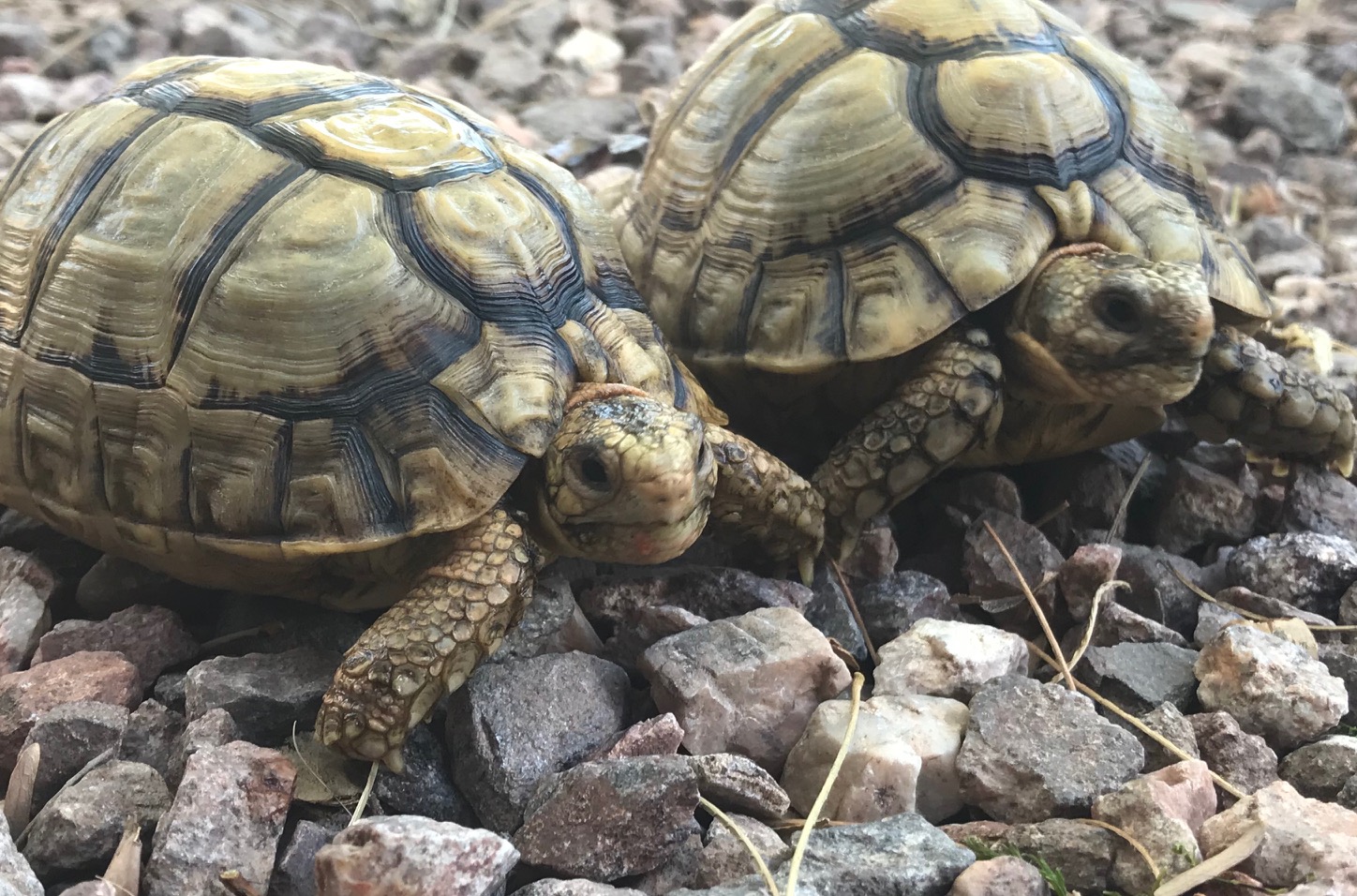
Egyptian Tortoise
Egyptian tortoises are a tiny species of tortoise historically from Egypt, Libya and Israel. They live in coastal sand dune areas that are very hot and dry as far as rainfall, but they get a morning fog that covers the area with moisture each day. Because of this, and taking advice from the breeder we acquired ours from, we run a fogger for about 30 minutes each morning right as the lights come on, and the tortoises get very active during this time, often sitting directly under the source of the fog. They are thought to be functionally extinct in Egypt and possibly also in Libya, but there is a small population hanging on in Israel. They haven't been imported into the US in many many years, so their population in the US is very low. The males barely reach 4" length, and the females may peak out around 5 or 6" length. When originally imported, the US requires a 4" minimum size on tortoises, and the original shipments were almost completely female because of that. The few males in the shipment were very old and many didn't transition well to captivity, so early on, males were impossible to get. The few that did make it produced a few more males, and a few generations later, we have finally caught up with the sex ratio problem here. Their very slow reproductive rate keeps them difficult to find, and like pancake tortoises, I expect these to just climb and climb in price because of it.

Yellowfoot tortoise
Yellowfoot tortoises are a jungle species from South America best suited to humid and warm areas. They are very much like a redfoot tortoise with a slight preference for more water and swampy conditions. They live near water in the wild in almost all cases (redfoots don't always). They average slightly larger than a redfoot. They can be very outgoing tortoises when housed in the right conditions. Babies tend to become lethargic if their humidity isn't high enough (80%+). I consider them somewhat difficult to keep because of that, but I'm in the desert. We raise them in enclosed cages that maintain high humidity. The adults we hang shade cloth over, and they have sprinklers on them for 60 second bursts several times a day. They don't handle winters without supplemental heat; we heat them or bring them in any time the nights are below about 50 degrees. Our heat and dryness negatively affects their fertility, but they seem to survive fine in the hot and dry conditions as long as you are getting water and shade on them.

Greek tortoise
Greeks are a small species that are one of our favorites in our dry hot climate. They have a massive natural range in the wild, and because of that, they have evolved in to many different subspecies with completely different looks and characteristics. There are many from the Middle East and North Africa that are generally lighter in color and handle heat well, and then there are some Northern types from Turkey, Iran and other areas that are much darker in color to absorb more heat from the sun in the cooler conditions in those areas. Either way they are an easy to keep tortoise that handles heat and cold well. We hibernate all of ours and they do well, even though there's some debate whether all forms will hibernate in the wild. The Southern forms are probably not quite as cold tolerant as a hermanns, Russian, or marginated tortoise, they do well in our (relatively mild) winters here buried in the ground with air temperatures above them occasionally in the high teens (they maintain a body temperature of 35-40 degrees when buried in the ground). I'm not sure I would trust them to hibernate thru a colder area's winter without problems. They are active and friendly, and their small size makes them easy to keep indoors or in larger numbers with limited space.
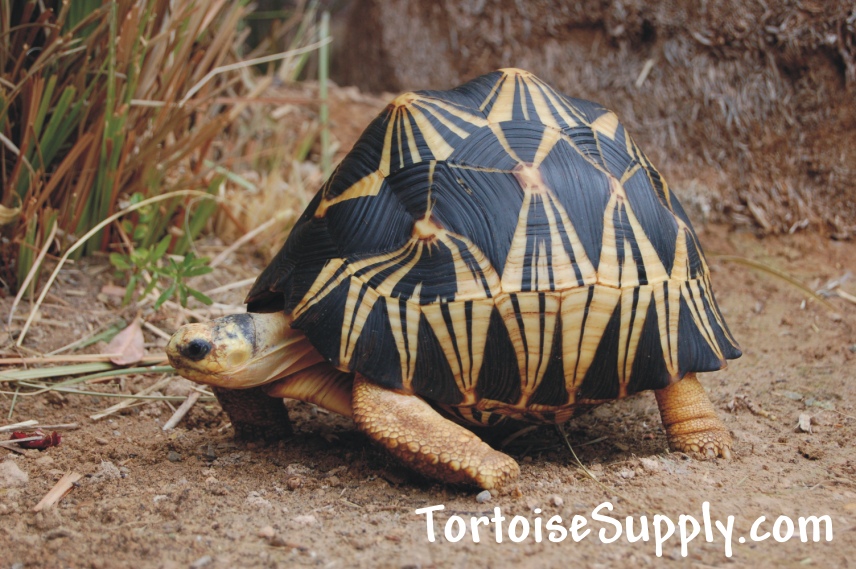
Radiated tortoise
These tortoises are considered the "crown jewel" by many tortoise keepers, the high end of the high end. They have a high domed shell, and look like bowling balls running around. They are friendly and active and easy to keep. They do well for us here in the desert, and handle high temperatures well. They don't seem sensitive to cold, although they are not hibernators, we keep the adults at 50 degrees or above (on cold nights, they are moved to a heated hide box). With prolonged cold they should be brought indoors. These tortoises are considered critically endangered by the international community due to their massive reduction in their wild range in Southern Madagascar. Currently, the government limits their movement within the United States, and sales are only legal in-state, or out of state if buyer and seller both have a special permit from USFWS. Because of this, buying and selling is very difficult unless you can find some available within your state, and there's only about 5 or 10 states that regularly have them being produced.

Aldabra Tortoise
These massive, impressive tortoises are most commonly kept and seen in zoos across the country. They come from an isolated Island chain in the Indian Ocean and have evolved very large with no natural predators. They are huge in size, with males nearing 500 pounds (females about 1/3 or 1/2 that). They prefer humid tropical conditions, but do well for us here in the desert as long as they have shade over them and plenty of water available. They are primarily grass eaters and larger animals will eat bailed hay similar to a sulcata tortoise. They obviously need a lot of space to wander around and work their legs. They are very prone to stance problems from being kept in smaller, flat bottom enclosures without hills and elevation changes that they need to keep proper functioning legs. Long necks enable them to reach food high off the ground, and in captivity, enrichment should be used to keep them stretching out (hanging food up high for them to reach, etc). They are still rarely bred in the United States, and the vast majority of the Aldabras in the US originated from commercial farms in the Seychelles Islands, where they breed them and then ship them in to the US.
Elongated & Forstens Tortoises
Elongated and Forstens tortoises are Asian species that are largely unknown in the United States. They are a small to medium sized tortoise that does well in humid, overcast areas that are warm (Florida, Washington state, Lousiana, etc). In a large enough enclosure, they'd do well indoors also, as they don't have high light requirements. They are known for their white head color and black eyes, and these are the most nocturnal species that we keep, more often than not, ours lay eggs at night which is the only species we have that does this. They like water and are very opportunistic feeders on small bugs, worms, and would eat small rodents or deceased animals if they happened upon them. Babies have very high humidity requirements, and they can be tricky to raise because of this.
Featured Products
-
$300.00

-
$250.00

-
$300.00

-
$650.00

 Loading... Please wait...
Loading... Please wait...

